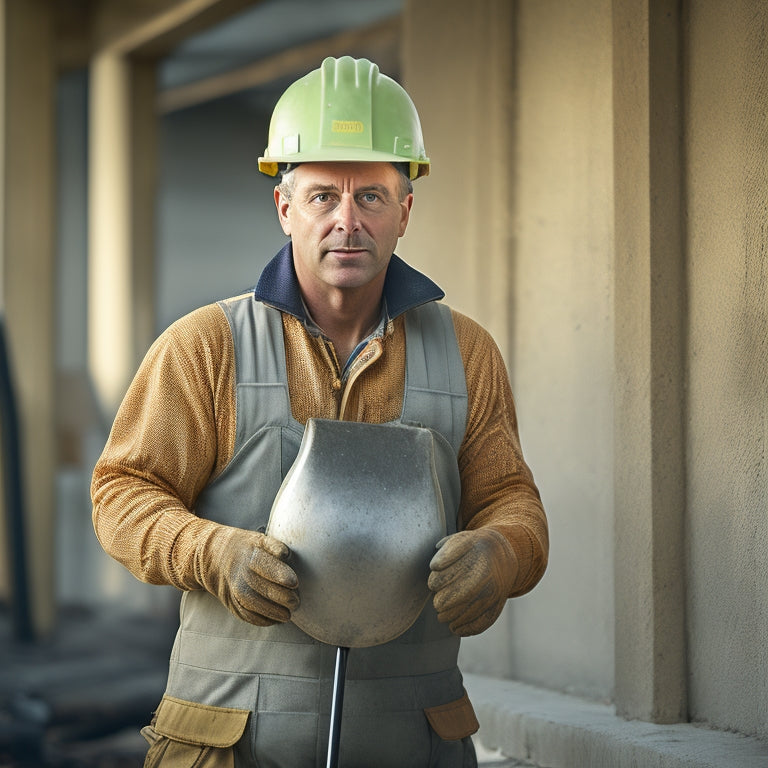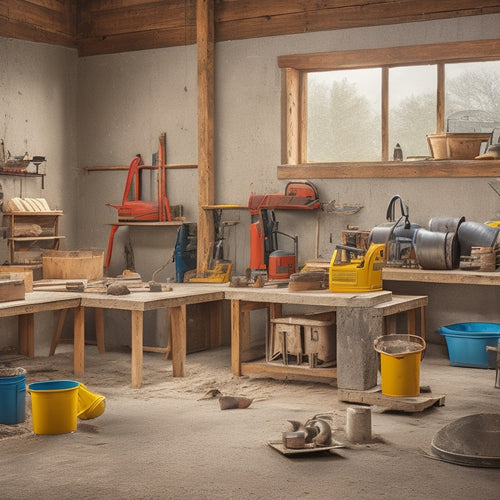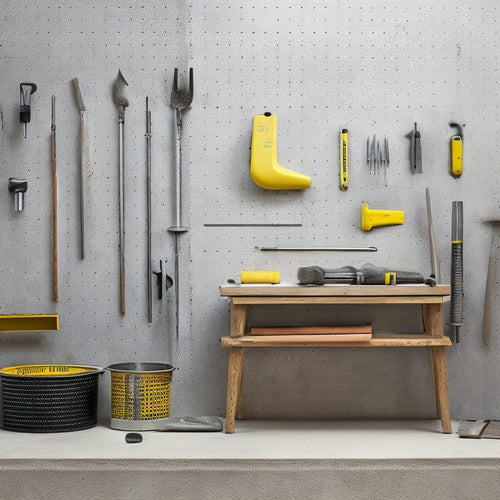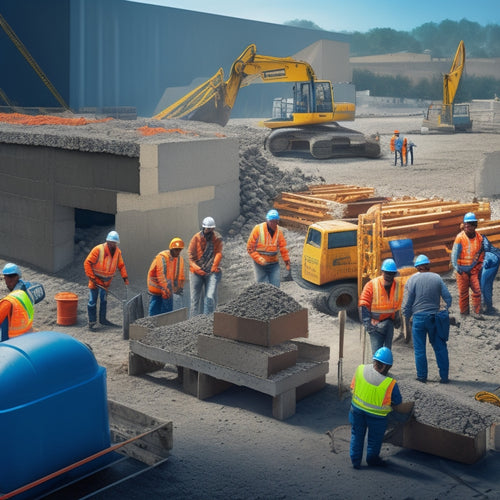
10 Affordable Tools for Concrete Wall Construction
Share
You'll need a range of tools to guarantee a successful concrete wall construction project. Start with measure and mark tools like durable fiberglass-reinforced measuring tapes and high-quality chalk lines. Next, invest in mixing and pouring essentials, block laying and alignment tools, and mortar application equipment such as sturdy mixing buckets, heavy-duty mixing drills, and mortar pump systems. Don't forget finishing and smoothing tools, cutting and drilling machines, material handling and transport equipment, leveling and straightening aids, and cleaning and maintenance tools. By investing in these 10 affordable tools, you'll be well on your way to a strong, durable, and professional-looking concrete wall - and there's even more to explore to take your project to the next level.
Key Takeaways
- Durable measuring tapes and high-quality chalk lines are essential for accurate layout and material placement at an affordable cost.
- Invest in a sturdy mixing bucket, heavy-duty mixing drill, and paddle attachment for efficient mortar mixing without breaking the bank.
- Spirit levels, string lines, and alignment tools are must-haves for accurate block laying and alignment at a reasonable price.
- A set of trowels, edgers, and floats can help achieve a professional-looking finish without overspending on mortar finishing accessories.
- Safety gear like respiratory protection, safety glasses, and gloves can be sourced affordably to ensure a safe working environment.
Measure and Mark Tools
Measuring and marking tools form the foundation of concrete wall construction, as they guarantee accurate layout and placement of materials. You'll need reliable tools to secure straight lines, precise angles, and accurate measurements.
Measuring tapes are essential for taking precise measurements, marking cut lines, and verifying the layout of your wall. Choose a durable, fiberglass-reinforced tape that can withstand the rigors of the construction site.
When it comes to marking lines, you'll need a high-quality chalk line that produces a clear, consistent mark. This will help you create straight lines and accurate angles, assuring your wall is built to last.
Look for a chalk line with a sturdy reel and a durable line that resists breakage. By investing in these fundamental tools, you'll be able to guarantee the accuracy and precision required for a successful concrete wall construction project.
Mixing and Pouring Essentials
With accurate measurements and markings in place, you can now focus on preparing the concrete mixture that will bring your wall to life.
To guarantee the mixture is strong and durable, you'll need to select the right concrete additives. These can include air-entraining agents, retarding agents, or accelerating agents, depending on the specific requirements of your project.
Next, you'll need to choose the appropriate mixing techniques. This may involve using a mechanical mixer, such as a drum mixer or a paddle mixer, or mixing by hand with a shovel or trowel. Be sure to follow the manufacturer's instructions for mixing and to mix in a well-ventilated area to avoid inhaling dust.
When mixing, start with the dry ingredients, then gradually add water while continuously mixing. Avoid overmixing, as this can lead to a weak and porous concrete.
Block Laying and Alignment
Proper block laying and alignment are essential to building a strong and stable concrete wall. You need to verify that each block is laid level, plumb, and aligned with the course above and below it. A well-planned block layout will help you achieve this.
To achieve accurate alignment, you'll need to use the right tools and techniques. Here are some essentials to get you started:
- A spirit level to check the block's level and plumb
- A string line to guide your block laying and verify straight courses
- A block alignment tool to maintain consistent spacing between blocks
- A rubber mallet to tap blocks into place without damaging them
- A chalk line to mark the block layout and courses on the foundation or previous course
Mortar Application Equipment
When building concrete walls, you'll need to apply mortar efficiently to guarantee structural integrity and a professional finish.
To do so, you'll require specialized equipment for mixing, pumping, and finishing mortar.
You'll find that mortar mixing tools, mortar pump systems, and mortar finishing accessories are essential components in your toolkit.
Mortar Mixing Tools
Efficient mortar mixing is essential for achieving strong, durable concrete walls. You need to ascertain that your mortar has the right consistency and is mixed using proper techniques to avoid weak points in your concrete structure.
To achieve this, you'll need the right tools for the job. Here are some essential mortar mixing tools you should have:
- A sturdy mixing bucket with a non-slip handle and a capacity of at least 5 gallons
- A heavy-duty mixing drill with a paddle or mixing bit attachment
- A mortar mixer or mixing hoe for manual mixing
- A trowel or scoop for measuring and mixing materials
- A mixing stick or paddle for scraping the sides and bottom of the mixing bucket
Remember to always follow safety guidelines when mixing mortar, such as wearing protective gear like gloves, safety glasses, and a dust mask.
Additionally, make sure you're working in a well-ventilated area and avoiding overmixing, which can lead to a weak and inconsistent mortar consistency.
Mortar Pump Systems
About 15 feet of vertical lift is typically the maximum height you can effectively place mortar using traditional methods, such as wheelbarrows and shovels. Beyond that, you'll need a more efficient and reliable solution to transport mortar to higher elevations.
This is where mortar pump systems come into play. These systems enable you to pump mortar up to 50 feet or more, greatly increasing your productivity and reducing labor costs.
When selecting a mortar pump system, consider factors such as mortar pump efficiency, pump pressure, and flow rate. Look for systems with variable speed controls to optimize pump performance and reduce wear on the equipment.
Regular pump system maintenance is also essential to guarantee consistent performance and prevent costly downtime. You should perform routine checks on the pump, hoses, and valves to identify potential issues before they become major problems.
Mortar Finishing Accessories
Mortar finishing accessories, also known as mortar application equipment, play an important role in achieving a smooth, even finish on your concrete walls.
These tools help you achieve the desired texture and appearance, ensuring a professional-looking result.
When working with mortar, you'll need the right accessories to apply and finish it correctly. Here are some important mortar finishing accessories to take into account:
-
Trowels: Choose from various types, such as V-notched, square-notched, or rounded-edge trowels, depending on the mortar type and desired finish. Mastering trowel techniques takes practice, but it's vital for a smooth finish.
-
Edgers: These tools help create clean edges and joints, ensuring a professional-looking finish.
-
Floats: Use floats to smooth out the mortar and remove excess material.
-
Tamping tools: These tools help compact the mortar, ensuring it's evenly distributed and preventing settling.
-
Jointers: Jointers are used to finish and seal joints, creating a watertight seal and preventing water damage.
Finishing and Smoothing Tools
With the concrete wall poured and set, you're now ready to focus on its surface finish. This stage requires the right tools to achieve the desired texture and smoothness. You'll need a range of finishing and smoothing tools to get the job done efficiently.
Trowel techniques play an essential role in achieving the desired texture finishes. A steel trowel is ideal for creating a smooth, even surface, while a wooden trowel is better suited for creating texture finishes. When using a steel trowel, hold it at a 45-degree angle and apply moderate pressure to achieve a smooth finish.
For a textured finish, use a wooden trowel and apply varying amounts of pressure to create the desired pattern.
In addition to trowels, you'll need other finishing tools such as edgers, floats, and darbies. Edgers help create a clean, defined edge along the wall's perimeter, while floats and darbies smooth out the surface and remove any imperfections.
Safety Gear and Protective Wear
As you focus on achieving a high-quality finish on your concrete wall, you're likely to generate dust, debris, and other hazards that can put your health and safety at risk.
To mitigate these risks, it's imperative to invest in proper safety gear and protective wear.
You'll need:
- Respiratory protection, such as dust masks or respirators, to prevent inhalation of harmful particles
- Safety glasses or goggles to protect your eyes from flying debris
- Gloves to prevent cuts and abrasions on your hands
- Steel-toed boots or shoes with slip-resistant soles to prevent foot injuries
- A hard hat to protect your head from falling objects or debris
Cutting and Drilling Machines
Frequently, you'll need to cut or drill into your concrete wall to create openings for electrical outlets, pipes, or other installations. For these tasks, you'll require specialized cutting and drilling machines designed for concrete.
Concrete saws are a staple in any concrete construction project. They're available in various sizes, from handheld models to walk-behind saws, and are ideal for making straight cuts or curves in concrete walls. When choosing a concrete saw, consider the blade type, as diamond blades are specifically designed for cutting through concrete and provide a cleaner, more precise cut.
For drilling, you'll need a rotary hammer drill or a core drill, depending on the size and type of hole you need to create. These drills are designed to withstand the rigors of drilling through concrete and are available in various sizes and types.
When operating these machines, always follow safety guidelines, wear appropriate protective gear, and guarantee a stable working environment to avoid accidents.
Material Handling and Transport
You've prepared your concrete wall for cutting and drilling, now it's time to focus on moving and placing the necessary materials and equipment around the construction site.
Material handling and transport are vital aspects of concrete wall construction, requiring careful planning and execution to guarantee a safe and efficient process.
To optimize your transport logistics, consider the following:
- Use forklifts or pallet jacks to move heavy materials, such as concrete blocks or steel reinforcement, around the site.
- Designate specific areas for material storage, keeping them organized, dry, and easily accessible.
- Utilize dollies or hand trucks to transport smaller, lighter items, like power tools or equipment.
- Implement a "just-in-time" delivery system to minimize on-site material storage and reduce congestion.
- Train your team on proper lifting and handling techniques to prevent injuries and damage to materials.
Leveling and Straightening Aids
Every concrete wall construction project requires precise leveling and straightening to secure a sturdy and durable structure. You can't afford to compromise on this critical aspect, as it directly impacts the overall integrity of the building.
To guarantee accurate leveling, you'll need reliable tools that provide precise measurements.
A plumb bob is a simple yet effective tool for verifying vertical alignment. By suspending the weighted string from the top of the wall, you can check if the wall is perfectly plumb. This traditional method may take some practice, but it's an affordable and reliable option.
For more complex projects or larger areas, consider investing in a laser level. This tool projects a level line or plane, allowing you to quickly identify any deviations from the desired orientation.
Laser levels are particularly useful for checking floor and ceiling levels, as well as guaranteeing that walls are straight and level.
Cleaning and Maintenance Tools
You'll need to clean your tools and equipment regularly to maintain their performance and extend their lifespan.
This involves removing concrete residue with a wire brush or scraper, dust-proofing surfaces daily with a soft-bristled broom or vacuum, and scrubbing tough stains with a stiff-bristled brush or scrubber.
Remove Concrete Residue
After pouring and finishing concrete, removing residue from tools and equipment is essential to prevent it from hardening and becoming difficult to clean.
You'll want to act quickly to avoid the hassle and safety risks associated with hardened concrete residue.
When it comes to concrete residue removal, you have several eco-friendly solutions at your disposal. Here are a few options:
- Use a pressure washer with a wide fan tip to remove large chunks of concrete from your tools and equipment.
- Apply a concrete dissolver to break down the residue, making it easier to remove.
- Utilize a wire brush or scraper to manually remove residue from smaller tools and crevices.
- Mix baking soda and water to create a paste that can help lift and remove concrete residue.
- Consider using a degreaser or soap solution to help loosen and remove residue from your tools and equipment.
Dust-Proof Surfaces Daily
Sweep away debris and dust from your concrete construction site daily to prevent damage and guarantee a smooth workflow. This vital step assures that your concrete walls are free from contaminants that can compromise their strength and appearance.
As you work on your concrete wall construction, you'll need reliable cleaning and maintenance tools to keep your site dust-proof. Invest in a heavy-duty broom or a dust-controlling vacuum to remove loose particles and debris from the surface.
Regularly cleaning your concrete surface prevents dust from accumulating and reduces the risk of damage. For more thorough cleaning, use a mop or a scrubber with a mild detergent to remove stubborn dirt and grime.
This surface treatment helps maintain a clean and even surface, allowing you to apply subsequent layers of concrete or finishes without issues.
Scrub Tough Stains
Concrete walls often face stubborn stains that resist regular cleaning methods. These stains can be a challenge to remove, but with the right tools, you can effectively eliminate them and guarantee proper surface preparation.
To scrub tough stains, you'll need:
- A stiff-bristled broom or brush to agitate the stain and loosen its bond with the concrete
- A cleaning solution specifically designed for concrete, such as a degreaser or acid-based cleaner
- A scrub brush or scrub pad to apply the cleaning solution and scrub the stain
- A pressure washer to rinse the area and remove any remaining residue
- Protective gear, including gloves, safety glasses, and a mask, to guarantee your safety while working with harsh chemicals and high-pressure water streams
Frequently Asked Questions
Can I Use a Regular Drill for Mixing Concrete?
You can't use a regular drill for mixing concrete; it's not designed for heavy-duty mixing and can lead to motor burnout or injury. Instead, opt for a drill specifically designed for mixing, such as a hammer drill or paddle mixer, and employ proper mixing techniques.
How Often Should I Clean My Concrete Construction Tools?
As you wield your trusty tools, remember that a clean slate is key to success - literally! You should clean your concrete construction tools daily, or after each use, to prevent concrete buildup and secure tool maintenance, guaranteeing a safe and efficient workflow.
Are Concrete Wall Construction Tools Suitable for DIY Projects?
You'll find that concrete wall construction tools are suitable for DIY projects if you're willing to learn concrete wall techniques and follow safety guidelines; however, note that DIY concrete tools may not be as heavy-duty as professional equipment.
What Is the Ideal Temperature for Concrete Wall Construction?
When you're constructing a concrete wall, you'll want to guarantee the ideal temperature for concrete curing, between 50°F and 70°F (10°C and 21°C), to avoid temperature effects that can compromise the structure's integrity and put people at risk.
Can I Rent Concrete Construction Tools Instead of Buying Them?
As you ponder the medieval notion of forging your own tools, consider renting concrete construction gear instead of buying; it's a 21st-century solution offering significant cost savings, allowing you to allocate funds to more critical aspects of the project.
Conclusion
You've got the arsenal of affordable tools to conquer concrete wall construction like a pro! With these essentials, you'll be building walls as fast as a speeding bullet, and with precision that'll make a Swiss watchmaker jealous. From measuring to finishing, you're now equipped to tackle any concrete wall project that comes your way. So, get building and watch your structures rise from the ground like a skyscraper!
Related Posts
-

What Tools to Rent for a Concrete Home Reno
When tackling a concrete home renovation, you'll need to rent a variety of specialized tools to get the job done. For...
-

10 Must-Have Tools for Concrete Repair Organization
You'll need a solid organization system to keep your concrete repair tools and materials within easy reach, protected...
-

7 Best Tools for Concrete Block Construction
You'll need a solid foundation, precise cutting, and seamless finishing to guarantee your concrete block construction...


